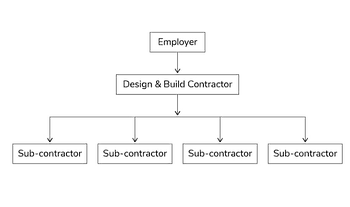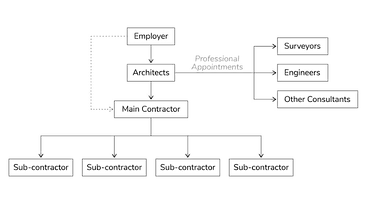Traditional Contract
Option 1

The client appoints consultants to design the project in detail and then prepare a tender document that includes different things such as drawings and work schedules. The contractors are then invited to submit tenders for the construction of the proposal.
The client has control of design over their appointed contractors and generally, there’s no design responsibility on the contractor. The client also tends to keep the design consultants for any problems or additional construction information needed during construction or to review any designs done by the contractors and to review works done. Traditional construction contracts tend to be paid in one lump sum, however, measurement contracts can also be used in traditional projects when the design and build of proposals are separate.
This procurement route gives the client certainty on cost and is suitable for clients who are experienced and inexperienced, however, it can be slower than other contacting types because the contractor is only chosen after the design is done and the contractors are unable to help and improve the buildability and packaging of proposals. It is seen as being a low-risk method as the contractor takes most of the financial risk, however, if design information is incomplete the cost to the client can be significant.
In this procurement route the contractor is appointed in both the design and construction, this method consists of one single point of responsibility for the entire project, however is prominently used when the design isn’t the key aspect.
The client gives a brief of what they want to the contractors then the contractor responds with the ‘contractors proposal‘ which includes both price and works. If the client wishes to have more control over the design they can employ someone to come up with concept design or performance specification to come given to the contractor once chosen to design and build.
The pros of this is that there is one person responsible for the oversee of it all as well as the contractors expertise being given from the start, there is also an early commencement on site as well as an early understanding of the price, however the negatives are that the client may find it difficult for the brief to be so specific that the outcomes perfectly correspond with there ideas and the client has to commit to the design early on in the project. The Design and build of a project are done in parallel so therefore the general time of the build is shorter.
Design & Build
Contract
Option 2

Our Recommendation:
Option 1

Both of these are viable options, however, CFT recommends that you chose the Traditional Procurement Route as the whole design will be done before it is given to the contractors and therefore you will be able to make changes throughout if there is something that aligns with your brief but doesn’t appear as you envision it. Although this might take longer than the Design and Build as it won't start construction until fully designed you have more control. We at CFT also have a specialist in the construction industry, and therefore you won't be missing out on the specialised input from the contractor's expertise.